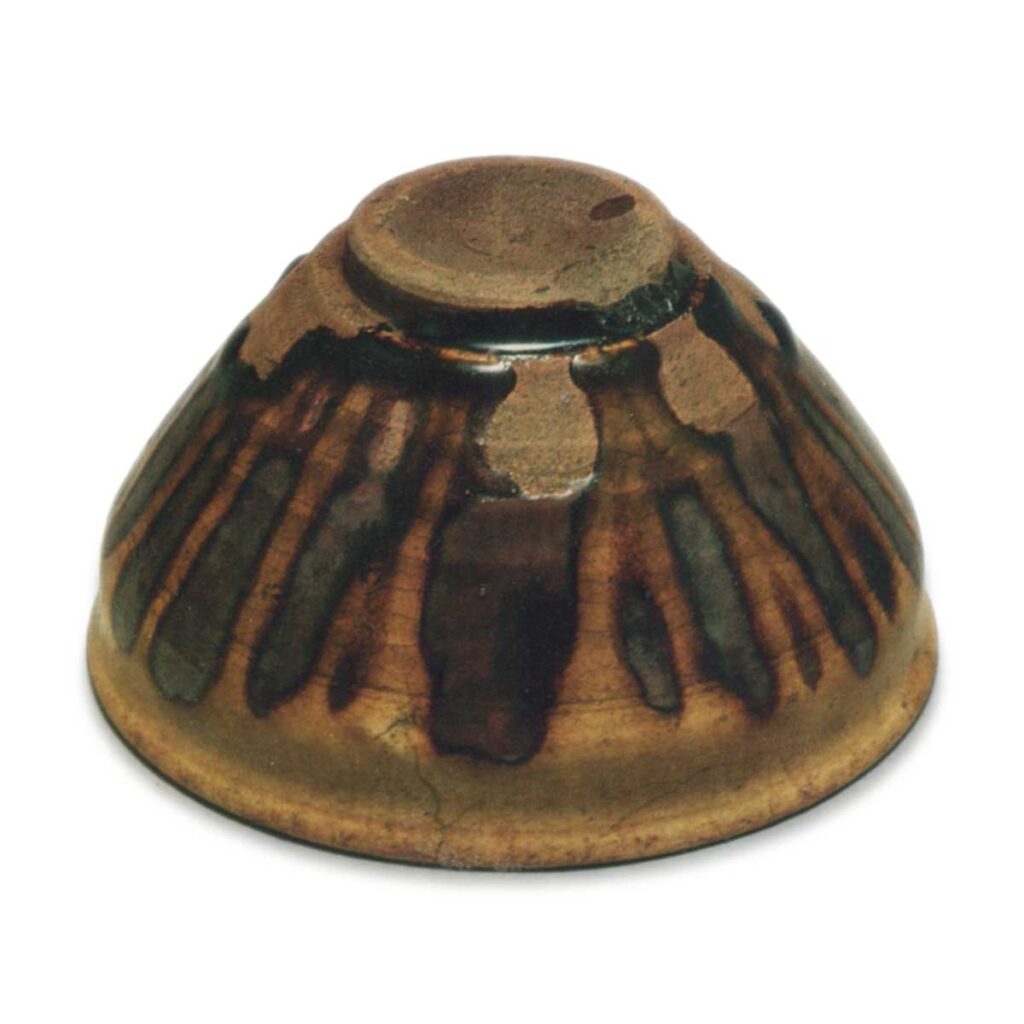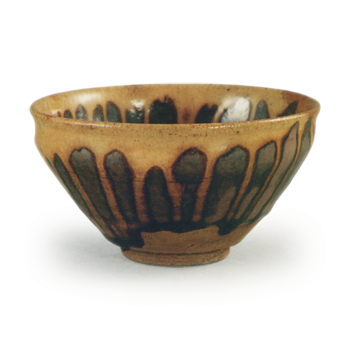

Important Cultural Property
Chuko Meibutsu
Collection: Fujita Museum of Art
Height: 6.6cm
Bowl diameter: 12.2cm
Outer diameter of base: 4.7cm
Height: 0.6 cm
This is a type of Seto tenmoku, called Kikka tenmoku by Enshu Kobori after the dark ame glaze applied on the inside and outside from under the mouth rim to the body, and the flowing yellow Seto glaze applied on the mouth rim, which stripes the inside and outside, giving it the appearance of a chrysanthemum flower.
The glaze is yellowish amber in the areas where the two glazes intermingle, and the petal-like areas become golden yellow, and the flowing ame glaze pools thickly on the prospective surface or drips onto the outer surface, showing glaze pools everywhere.
The mouth is modeled after the tenmoku type, but the base is low and large, a characteristic shared with Seto tenmoku of the late Muromachi period. The shallow chipping inside the base, the chipping on the sides of the base, and the application of a cast glaze on the earthenware surface are also in the Seto Tenmoku style.
Chrysanthemum tenmoku is extremely rare, and only one other similar piece is known today. However, the Yukiyanagi technique of the Shunkei teapot was the same as the Kikka Tenmoku technique, in which a Kizukatenmoku glaze was applied over a dark ame (ame) glaze.
However, the rarity of the chrysanthemum tenmoku suggests that it was probably made only in specific quantities, depending on taste. In the Muromachi period (1336-1573), there were already Seto tea containers that were fired only a certain number of times, so the Kikka Tenmoku probably belongs to this category.
For this reason, it has been prized as one of the rarest of Seto tenmoku since ancient times, and is listed in Enshu’s “Enshu’s Collection Book” with a boxed inscription by Enshu, and is also noted in tea ceremony books. For example, in the “Meiri-so” there is a note that says, “The chrysanthemum flower tenmoku has the same characteristics as the white tenmoku, and there is a pattern of chrysanthemum flowers in the tenmoku with a gold powder, which is so beautiful that I think it should be the same as Hakuan.
The “Meimono Meirisho” also states, “Kikka Tenmoku Kobori. The inside and outside are covered with a yellow Seto glaze, and the outside is covered with a yellow Seto glaze.
In short, chrysanthemum tenmoku has been valued as the best of all Seto tenmoku since ancient times, and the rarity of this relic adds even more value to the piece. The main attraction of this piece is the beautiful chrysanthemum design itself, which is reflected in the brilliant kinke glaze on the yellow Seto ground, which is why Enshu called it “Kikka Tenmoku” and highly valued it. In this sense, it can be said that even the dawn of the Momoyama style has already begun to emerge.
The dark candy-colored glaze is also very attractive, but there is one spot in the center of the bowl where a stone haze adds further interest to the scene. There are two large and two small pieces of brittle porcelain on the rim and a single vertical penetration. There is a spot of skipped glaze in the base and a glaze puddle on the side of the base.
This piece is from a vase with a box inscribed by Kobori Enshu. It was in the possession of the Kobori family, but left the Kobori family in An’ei 4, when Kobori Izumi-no-mori was governor of Izumi, and passed to Matayoshi in Osaka, where it later passed to the Matsudaira family of the Ueda domain in Shinshu. When the Matsudaira family sold it in 1913, it became the property of the Fujita family of Osaka, and later became part of the collection of the Fujita Museum of Art when it was established.



